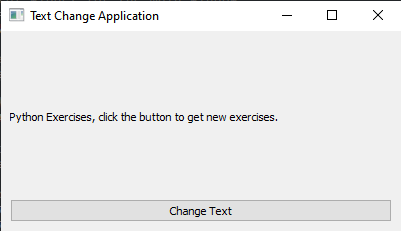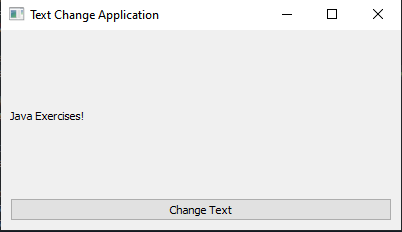Python PyQt text display application
Write a Python program using PyQt5 that creates an application with a QPushButton and a QLabel. Whenever the button is clicked, the label's text should change.
Note:
The QPushButton widget provides a command button.
The QLabel widget provides a text or image display.
From doc.qt.io:
QApplication Class: The QApplication class manages the GUI application's control flow and main settings.
QMainWindow Class: The QMainWindow class provides a main application window.
QPushButton: The push button, or command button, is perhaps the most commonly used widget in any graphical user interface. Push (click) a button to command the computer to perform some action, or to answer a question. Typical buttons are OK, Apply, Cancel, Close, Yes, No and Help.
QLabel Class: The QLabel widget provides a text or image display.
QVBoxLayout Class: This class is used to construct vertical box layout objects.
QWidget: The QWidget class is the base class of all user interface objects.
Sample Solution:
Python Code:
import sys
from PyQt5.QtWidgets import QApplication, QMainWindow, QPushButton, QLabel, QVBoxLayout, QWidget
class TextChangeApp(QMainWindow):
def __init__(self):
super().__init__()
# Set the window properties (title and initial size)
self.setWindowTitle("Text Change Application")
self.setGeometry(100, 100, 400, 200) # (x, y, width, height)
# Create a central widget for the main window
central_widget = QWidget()
self.setCentralWidget(central_widget)
# Create a QLabel to display text
self.label = QLabel("Python Exercises, click the button to get new exercises.")
# Create a QPushButton
self.button = QPushButton("Change Text")
# Create a vertical layout
layout = QVBoxLayout()
# Add widgets to the layout
layout.addWidget(self.label)
layout.addWidget(self.button)
# Set the layout for the central widget
central_widget.setLayout(layout)
# Connect the button click event to the change_text function
self.button.clicked.connect(self.change_text)
def change_text(self):
# Change the text of the label when the button is clicked
new_text = "Java Exercises!"
self.label.setText(new_text)
def main():
# Create a PyQt application
app = QApplication(sys.argv)
# Create an instance of the TextChangeApp class
window = TextChangeApp()
# Show the window
window.show()
# Run the application's event loop
sys.exit(app.exec_())
if __name__ == "__main__":
main()
Explanation:
In the exercise above -
- Import the necessary modules.
- Create a custom "TextChangeApp" class that inherits from "QMainWindow."
- Inside the class, create the window and widgets (QLabel and QPushButton) as well as set their properties and layout.
- Connect the button's click event to the change_text method, which changes the QLabel text when the button is clicked.
- In the main function, we create an instance of 'TextChangeApp', show the window, and start the application's event loop.
Output:
Flowchart:


Go to:
Previous: Creating a text display application with PyQt.
Next: Creating a custom widget with PyQt.
Python Code Editor:
What is the difficulty level of this exercise?
Test your Programming skills with w3resource's quiz.


